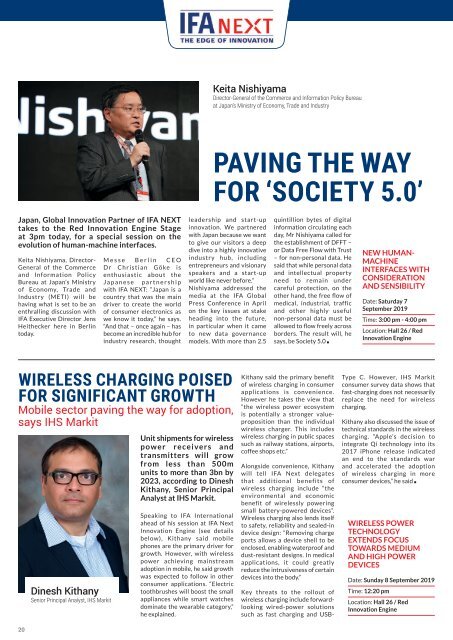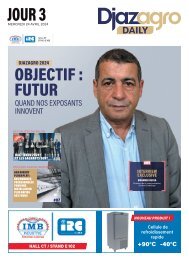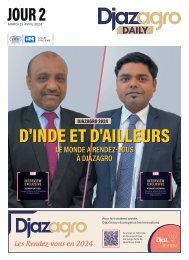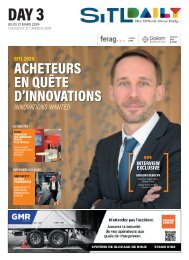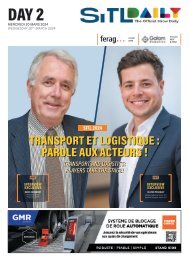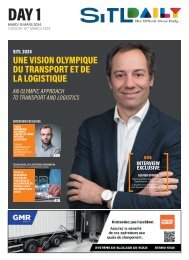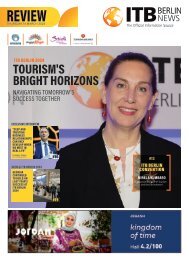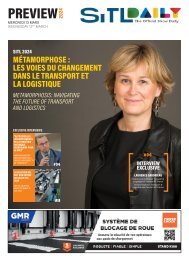IFA International 2019 Week-End Edition
Create successful ePaper yourself
Turn your PDF publications into a flip-book with our unique Google optimized e-Paper software.
Keita Nishiyama<br />
Director-General of the Commerce and Information Policy Bureau<br />
at Japan’s Ministry of Economy, Trade and Industry<br />
PAVING THE WAY<br />
FOR ‘SOCIETY 5.0’<br />
Japan, Global Innovation Partner of <strong>IFA</strong> NEXT<br />
takes to the Red Innovation Engine Stage<br />
at 3pm today, for a special session on the<br />
evolution of human-machine interfaces.<br />
Keita Nishiyama, Director-<br />
General of the Commerce<br />
and Information Policy<br />
Bureau at Japan’s Ministry<br />
of Economy, Trade and<br />
Industry (METI) will be<br />
having what is set to be an<br />
enthralling discussion with<br />
<strong>IFA</strong> Executive Director Jens<br />
Heithecker here in Berlin<br />
today.<br />
Messe Berlin CEO<br />
Dr Christian Göke is<br />
enthusiastic about the<br />
Japanese partnership<br />
with <strong>IFA</strong> NEXT: “Japan is a<br />
country that was the main<br />
driver to create the world<br />
of consumer electronics as<br />
we know it today,” he says.<br />
“And that – once again – has<br />
become an incredible hub for<br />
industry research, thought<br />
leadership and start-up<br />
innovation. We partnered<br />
with Japan because we want<br />
to give our visitors a deep<br />
dive into a highly innovative<br />
industry hub, including<br />
entrepreneurs and visionary<br />
speakers and a start-up<br />
world like never before.”<br />
Nishiyama addressed the<br />
media at the <strong>IFA</strong> Global<br />
Press Conference in April<br />
on the key issues at stake<br />
heading into the future,<br />
in particular when it came<br />
to new data governance<br />
models. With more than 2.5<br />
quintillion bytes of digital<br />
information circulating each<br />
day, Mr Nishiyama called for<br />
the establishment of DFFT –<br />
or Data Free Flow with Trust<br />
– for non-personal data. He<br />
said that while personal data<br />
and intellectual property<br />
need to remain under<br />
careful protection, on the<br />
other hand, the free flow of<br />
medical, industrial, traffic<br />
and other highly useful<br />
non-personal data must be<br />
allowed to flow freely across<br />
borders. The result will, he<br />
says, be Society 5.0<br />
NEW HUMAN-<br />
MACHINE<br />
INTERFACES WITH<br />
CONSIDERATION<br />
AND SENSIBILITY<br />
Date: Saturday 7<br />
September <strong>2019</strong><br />
Time: 3:00 pm - 4:00 pm<br />
Location: Hall 26 / Red<br />
Innovation Engine<br />
WIRELESS CHARGING POISED<br />
FOR SIGNIFICANT GROWTH<br />
Mobile sector paving the way for adoption,<br />
says IHS Markit<br />
20<br />
Dinesh Kithany<br />
Senior Principal Analyst, IHS Markit<br />
Unit shipments for wireless<br />
power receivers and<br />
transmitters will grow<br />
from less than 500m<br />
units to more than 3bn by<br />
2023, according to Dinesh<br />
Kithany, Senior Principal<br />
Analyst at IHS Markit.<br />
Speaking to <strong>IFA</strong> <strong>International</strong><br />
ahead of his session at <strong>IFA</strong> Next<br />
Innovation Engine (see details<br />
below), Kithany said mobile<br />
phones are the primary driver for<br />
growth. However, with wireless<br />
power achieving mainstream<br />
adoption in mobile, he said growth<br />
was expected to follow in other<br />
consumer applications. “Electric<br />
toothbrushes will boost the small<br />
appliances while smart watches<br />
dominate the wearable category,”<br />
he explained.<br />
Kithany said the primary benefit<br />
of wireless charging in consumer<br />
applications is convenience.<br />
However he takes the view that<br />
“the wireless power ecosystem<br />
is potentially a stronger valueproposition<br />
than the individual<br />
wireless charger. This includes<br />
wireless charging in public spaces<br />
such as railway stations, airports,<br />
coffee shops etc.”<br />
Alongside convenience, Kithany<br />
will tell <strong>IFA</strong> Next delegates<br />
that additional benefits of<br />
wireless charging include “the<br />
environmental and economic<br />
benefit of wirelessly powering<br />
small battery-powered devices”.<br />
Wireless charging also lends itself<br />
to safety, reliability and sealed-in<br />
device design: “Removing charge<br />
ports allows a device shell to be<br />
enclosed, enabling waterproof and<br />
dust-resistant designs. In medical<br />
applications, it could greatly<br />
reduce the intrusiveness of certain<br />
devices into the body.”<br />
Key threats to the rollout of<br />
wireless charging include forwardlooking<br />
wired-power solutions<br />
such as fast charging and USB-<br />
Type C. However, IHS Markit<br />
consumer survey data shows that<br />
fast-charging does not necessarily<br />
replace the need for wireless<br />
charging.<br />
Kithany also discussed the issue of<br />
technical standards in the wireless<br />
charging. “Apple’s decision to<br />
integrate Qi technology into its<br />
2017 iPhone release indicated<br />
an end to the standards war<br />
and accelerated the adoption<br />
of wireless charging in more<br />
consumer devices,” he said<br />
WIRELESS POWER<br />
TECHNOLOGY<br />
EXTENDS FOCUS<br />
TOWARDS MEDIUM<br />
AND HIGH POWER<br />
DEVICES<br />
Date: Sunday 8 September <strong>2019</strong><br />
Time: 12:20 pm<br />
Location: Hall 26 / Red<br />
Innovation Engine


